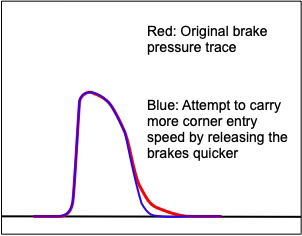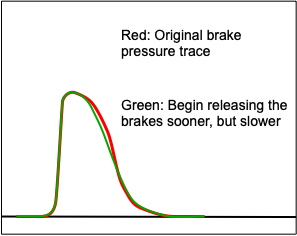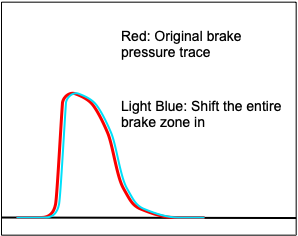Imagine you’re a car. Just for fun, let’s say you’re Cruz Ramirez, the anthropomorphic race car from the movie, Cars 3.

Now, imagine you — Cruz, the car — heading down a long straightaway, approaching a slow-ish corner, one that needs a fair amount of braking and downshifting.
You feel the energy of your engine powering yourself forward, your rear-end slightly squatted down, with your driver pushing fully on your throttle pedal.
Then, suddenly, as your driver lifts off your throttle and quickly applies the brakes, it’s as if your eyeballs are being forced out of their sockets, and your nose is being thrust towards the track surface. With each downshift, your power source is revved, and then it tapers off as you slow, slow, slow.
The energy is flowing through all parts of you: from forward thrust to nose-down deceleration; from your engine powering you forward to one revving and assisting your brakes in slowing down; and the energy from the clamping force of your brake pads on the disks turning into heat energy.
You’re about the distance of the length of your body from that point where your driver turns your steering wheel into the corner and you attempt to switch directions from forward movement to a curved path through the upcoming turn, when…
Your driver releases pressure from your brake pedal. You raise your nose. You reduce your deceleration rate.
“What’s going on?! What am I to do?” you ask yourself. You feel aimless, like you no longer have a purpose in life. You feel lifeless, lethargic, like you have no energy to do anything. And that’s when your driver suddenly asks you to change direction and go over there!
“Huh? You deprive me of my energy, and then ask me to do something? Sorry, but I can’t react that quickly. Okay, give me a sec, I’ll get around to it.”
And that’s when you begin to change direction — a second or two after your driver requests it. If only they hadn’t taken that feeling, that joy of having energy in your muscles, your bones, your chassis, you would have gladly and instantly changed direction for them. But it was that moment when they didn’t ask anything of you — or nearly anything of you — just prior to turning your steering wheel that almost lulled you to sleep.
“See, I love being engaged with my driver, being asked to accelerate, brake and turn. But I hate the feeling of near-nothing in between.
“I have one request of you, dear driver: Put and keep energy in me, by smoothly transitioning from one control input to another — even a bit of overlap is okay sometimes — so there’s energy in me. Don’t waste my time — or your time — by having me do nearly nothing.
“The thing I hate most is when you arrive at a corner and release my brakes a fraction of a second too soon so that I feel as if you don’t know what you want me to do. Like you don’t know what you want to do! It’s very difficult for me to help you if you’re expecting me to do something after you’ve practically told me you don’t want anything from me.
“Begin braking late enough so you arrive at the turn-in point with a little more brake pressure on so I feel as if I have some energy in me — so I’m front-loaded — when you ask me to change direction. Then, I’ll be more than happy to respond to your requests.
“Energize me, please.”
Make sure your car has energy in it when you turn in.
Okay, welcome back to the real world (or was that the real world?).
Let’s say that you realize that you’ve over-slowed for a specific corner, so on the next lap you decide to ease off the brakes a bit earlier, so you roll a bit more speed into the turn. You begin braking where you have in the past, but as you get to and around the turn-in point, you take your foot off the brake pedal a little quicker than you have on the previous laps (shown in the blue data trace illustration below). Yes, you’re now carrying more speed into the corner, so your minimum speed is higher, but what’s the challenge you’re likely facing? Yes, getting the car to turn, or rotate, enough so that you can begin applying the throttle as early as you have in the past. Because you’ve unloaded the front tires, your car doesn’t turn as much, it delays when you begin to accelerate, and you’re actually slower through that section of track.

Conclusion: “That didn’t work. My car won’t allow me to carry more entry speed.”
It wasn’t the increase in speed that caused you to be slower through this section of track, though. It was the lack of “energy” in the car when you turned in to the corner. By easing off the brakes quicker/sooner, the front tires were unloaded (less “energy” in them), and your car didn’t change direction the way you wanted. It’s human nature to think that you should go back to what you did in the past because it worked — kinda.
What if, though, you did one of these two options?
1. Instead of making your End-of-Braking (EoB) earlier by easing off the brakes quicker, you begin releasing the brakes sooner and slower (shown in the green data trace below). This would result in the EoB being in approximately the same place, but by beginning to release the brake pressure sooner,you’ll be carrying a little more speed at that point. And, your car will have “energy” in it, and rotate or turn into the corner.

2. You shift the entire brake zone in, from the BoB to EoB (shown in light blue below). Again, you’ll arrive at the EoB with more speed and energy in it — with enough load on the front tires to help the car turn.

I hope what you’re seeing here is that in addition to where you begin braking, and where you end braking, you’re managing the load on the front tires. You’re managing the energy in the car.
I can’t tell you the number of drivers I’ve watched or coached who decided to turn a faster lap by getting off the brakes sooner to carry momentum through the corner, only to find that they went slower. They had the right intentions — increase corner minimum speed — but just went about it the wrong way.
In fact, I think every driver has had the experience of approaching a corner, braking, braking, braking… then realizing they braked so early that they almost had to accelerate to get to the corner!
What do drivers do when they begin braking too early? End their braking too early. In other words, they lift off the brake pedal. Then, when they turn into the corner, the car is in limbo — it doesn’t have much, if any, load on the front tires; it may even be coasting. Your car doesn’t like to be in limbo. It does love to brake, corner, and accelerate — and even combine those three things. But, turning into a corner with the car in “limbo mode,” it doesn’t react the way you want; it feels unresponsive. And it doesn’t matter whether you’re pretty much at the limit, or quite a way from the limit.
Again, you need energy in the car when you get to the turn-in point so you can make the car do what you want. By having load on the front tires, the car has energy in it, and therefore it will respond to your inputs better.
With the objective of driving smoothly, some drivers approach corners without enough energy in the car. If you turn into a corner and feel that your car is not responding as well as you’d like, it’s likely that you don’t have enough energy in it. Think about the brake zone on the approach to the corner. What would happen if you moved it in half to a full car’s length further into the corner? Would the front tires have more load on them? Would that help the car turn more responsively?
Yes, moving the brake zone further into a corner requires you to brake later, and that can sometimes be, well… unnerving. But it’s less unnerving when you think about it as doing everything exactly like you have been, only now you’re moving it all a little bit further into the corner. See, it’s not about braking later (compressing the brake zone). It’s about doing the same thing as you are now, only a bit later. And I’m not talking about beginning your braking 50 yards or meters later. No, just a car’s length (or less), and it’s moving both the BoB and EoB that much later.
Think about how your car will feel when you do this. It won’t feel like you left it in limbo. No, it’ll feel as if you’re an active participant in the braking/cornering process. You’re putting energy into it, and it will respond in a positive way in return. You’re giving it energy, and it’ll give you cornering speed and responsiveness in return.
The next time you’re feel as though your car is not as responsive as you’d like when you turn into a corner, ask yourself whether you’ve put enough energy into it.
